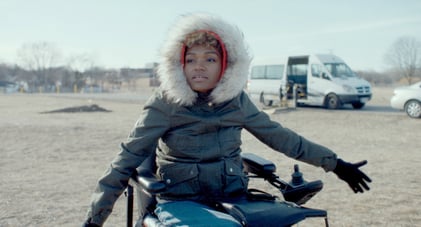Seeing ourselves on TV
It is a truism so common and perhaps trite as to often pass unnoticed that media representation in a media-saturated culture can have a direct effect on how people see themselves in their real lives.
Indian-Americans don’t like to be depicted like Abu Nahasapeemapetilion, the Indian Kwik-E-Mart owner in “The Simpsons,” though he is a beloved character to most of America. Poor white people from the country are still mercilessly stereotyped on TV as dumb and toothless and more recently, dumb and toothless and opioid-addicted. Evangelical Christians see themselves represented as either sanctimonious or hypocrites, every young black or Latino male is portrayed as a drug-dealing gangbanger, the list goes on and on. Media misrepresentation is a massive problem.
People with disabilities, on the other hand, are rarely grossly misrepresented on TV and film these days. They aren’t represented at all. They remain largely invisible, as if 61 million, extremely diverse people are simply non-existent when writers in Hollywood sit down to invent a story. This is slowly changing, the operative word here being slowly. A recent report by the LGBTQ group, GLAAD, discovered the number of regular characters with disabilities on all of broadcast television went from 18 characters (2.1%) in 2018 to 27 characters (3.1%) in 2019. Believe it or not, this is serious progress.
If you advocate for greater inclusion of people with disabilities in the media, both in front of and behind the camera, as I do, the future seems upbeat. We are a long way from 1981, the year that Geri Jewell, the actress with CP playing Cousin Geri on the NBC sitcom, “The Facts of Life,” was the first and only recurring character with a visible disability on network TV. For the next 30-some years, progress was glacial and sporadic. Remember “Corky” on the ABC series, “Life Goes On,” the first major character with Downs syndrome on TV or Danny Woodburn as Kramer’s little person friend, Micky, on “Seinfeld”? You probably remember them, and a few others, because they were both rare and good. And they weren’t one-dimensional “inspiration porn,” like secondary disabled characters have always been portrayed in the media.
Ask Hollywood disability insiders and they will tell you that a feeling of real change began about three or four years ago. Awareness had reached a new plateau. All of a sudden, shows on network, cable, and the new streaming services appeared with all kinds of disabled folks. I’ll just throw out some titles: “Breaking Bad,” “Parenthood,” “Speechless,” “The Good Doctor,” “NCIS: New Orleans,” “Atypical,” “Ramy,” “This Close,” and “Special.” They run from major network hits to small cable/streaming gems. And there are many more performers with disabilities in commercials, in guest roles, and even on reality shows like “America’s Got Talent.”
The annual Hollywood event that recognizes disability inclusion, the Media Access Awards, just celebrated its 40th anniversary. Begun in 1979 by Fern Field and Norman Lear, the man who also brought you Cousin Geri, this non-televised awards event was decades ahead of its time. It ran out of money for a few years and was revived in 2010, right on the cusp of the current uptick of disability stories and roles, and the 40th anniversary show this year was a glittery affair hosted by legendary actor, Joe Mantegna, and the deaf co-creator and star of Sundance’s “This Close,” Shoshannah Stern. Have you heard of one of the MAA winners, the movie, “The Peanut Butter Falcon”? You’ll soon be able to get in on Netflix or Amazon. It stars a teen with Down syndrome named Zack Gottsagan who is so good that there is even Oscar buzz around him. Check it out.

From the moment the awards re-solidified in 2010, the Reeve Foundation has been there to support and encourage. Through Sam Maddox, the former Reeve content manager, they revived the Christopher Reeve Acting Scholarship, an endeavor created by Christopher Reeve himself. This annual cash gift helps young actors with disabilities to move up the ladder – get all-important headshots, find an agent, take acting lessons.
This year’s recipient of the Reeve Scholarship is particularly noteworthy. Her name is Lauren “Lolo” Spencer, a wheelchair user with only one major acting role to her credit, in an independent film called “Give Me Liberty,” for which she got paid, by the way, next to nothing. Just a few days ago it was announced that Lolo had received a nomination for Best Supporting Female at the prestigious Film Independent Spirit Awards, alongside major stars like Jennifer Lopez and Octavia Spencer. She is on her way, backed by the Reeve Foundation.
As we all know, “every time a bell rings, an angel gets its wings.” Well, every time a performer with a disability gets seen and recognized, we can all flap our wings and fly a little higher.
Join Our Movement
What started as an idea has become a national movement. With your support, we can influence policy and inspire lasting change.
Become an Advocate